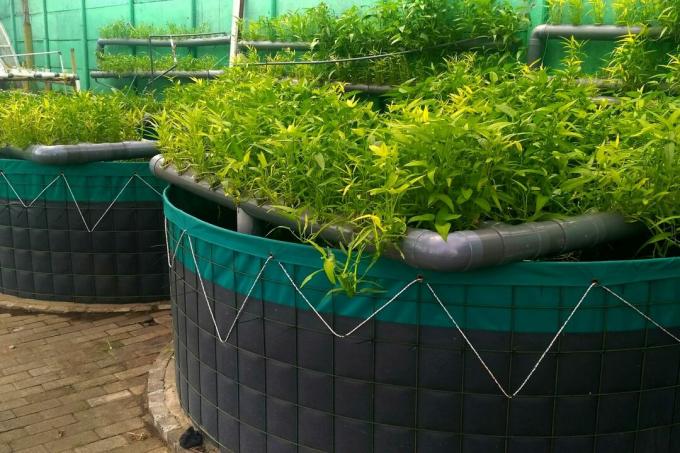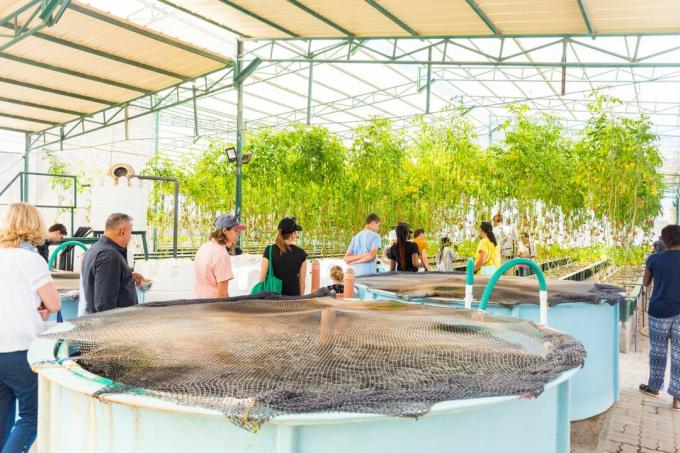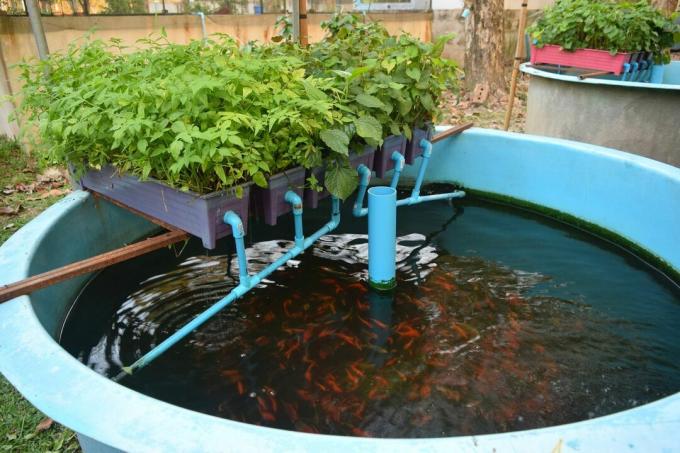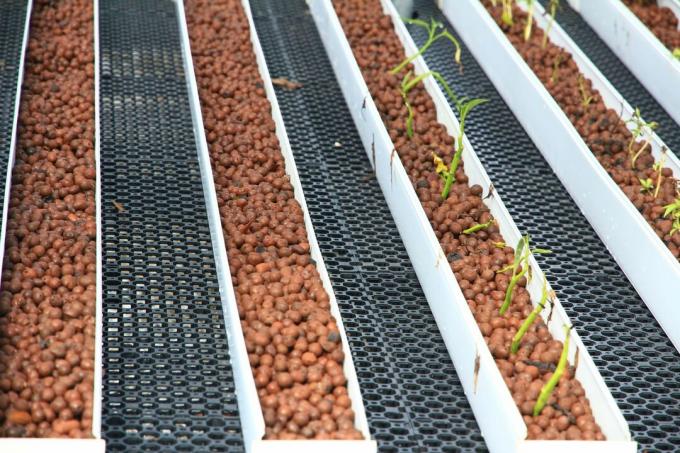Aquaponics can be an alternative to ensure nutrition in urban areas. We take a close look at the symbiosis of fish and plants for you.

Aquaponics is a combination of AQUAculture and HydroPONICS. Aquaculture refers to the controlled rearing of aquatic life - especially fish - for example in ponds or basins. This form of fishing is of great importance, especially due to the critical overfishing of the world's oceans. Hydroponics is a special cultivation method of plants. They are not used in organic substrates made from peat or based on compost. In hydroponics, inorganic materials such as rock wool or expanded clay are used for rearing, or the plants can be rooted directly in water. In aquaponics, the two independent production processes of fish and plants are combined.
contents
- A symbiosis in which there are only winners
- Aquaponics: the technical structure
- Aquaponics: a system for the future?
A symbiosis in which there are only winners
Why can the production of fish be combined with that of plants (mainly vegetables)? The answer is actually quite simple: Because both organisms need water to live. But in aquaponics, fish and plants are not only dependent on water - the two partners cannot do without each other either. The way aquaponics works is as simple as it is ingenious: the fish pollute the water with their excrement. This requires water treatment to maintain water quality. This in turn keeps the fish alive. In principle, an aquaponic system can be operated with any fish species. However, cichlid species in particular are very popular because they have a high growth rate and a favorable feed quotient. The nitrogenous compound ammonia (NH3), which can be introduced into the water via fish droppings but also partly through uneaten food harmful to the fish, but at the same time has the potential to act as a fertilizer for the plants act. However, ammonia is not yet directly available to plants. So-called nitrifying bacteria, which settle on special filter media, ensure that the ammonia is converted into nitrate (NO3) – a nitrogen compound that can now be taken up by the plants. With the help of the important nitrifying bacteria, the plants take care of their nitrogen uptake for purification of the water and thus ensure a habitat in which the fish survive be able. So while the plants get fertilizer from the fish, the plants clean the water for the fish with the nitrogen uptake. The symbiosis between fish and plant creates a win-win situation for everyone involved.

Aquaponics: the technical structure
Aquaponics technology, the basic system of which was already known and researched in the former GDR, works in a circulatory system. The water is pumped to the plants and from there it flows back into the fish tank. A filter device must be installed either integrated in this cycle or connected in parallel. This is where the essential nitrification of the nitrogen compounds by bacteria takes place. This filter device is, so to speak, the heart of every aquaponic system. Therefore, this should be planned with great care. The size of the filter is of course to be calculated according to the fish stocking density and the amount of food. The size of the plant beds should also be determined depending on the stocking density and the individual nutrient requirements of the cultivated plant species. The form of aquaponics shown here, in which fish and plants are connected directly via a water cycle, has a major disadvantage are interconnected: it is not possible to simultaneously determine the specific optimum pH values for fish and plants set. In addition, the plants are only supplied with nitrogen in sufficient quantities. A supplementary administration of other nutrients is not possible due to the excessive stress on the fish. The solution is a two-way cycle, in which there is a separate water cycle for the plants, which is always fed with water from the fish cycle. Thanks to the two separate circuits, additional fertilization of the plants is possible.

There are various ways of growing plants in a hydroponic system such as aquaponics. One possibility is to create large beds, so-called “grow beds”, with gravel or expanded clay. The plants take root in this inorganic substrate, which is periodically flooded with water from the fish tank.

The culture of the vegetables using the "Nurtient Film Technique" (NFT for short) is another option in aquaponics. Here the plants are in pipe systems with a slight incline, through which a constant trickle of water flows runs into the fish tank water and nourishes the plants before being returned to the fish tank will. Another cultivation method is the "Deep Water Culture". The water is pumped by the fish into another 15 to 30 cm shallow basin. Styrofoam plates with holes lie on the water surface in this pool. The plants are placed on the styrofoam and their roots come into contact with the water through the embedded hole. The plants root directly into the water. It is important to ensure that the underwater roots are supplied with additional oxygen so that the roots do not die off.

Aquaponics: a system for the future?
Not only research institutions like the Leibniz Institute for Freshwater Ecology and Inland Fisheries (IGB) in Berlin deal intensively with the subject of aquaponics. In the meantime, a huge competent fan base has spread on the Internet, which leads to a lively exchange in forums about the self-construction and operation of home aquaponic systems. In the context of the environmental debate, the symbiosis of fish and plants can have positive properties compared to conventional vegetable production show off: Significant water savings, savings in mineral fertilizers and the resulting relief of our farmland are some of the positive effects of a aquaponic facility. This cultivation system is ideal for regional food supply in urban areas, since the synergy effect depends on the situation Waste heat from technical equipment in other buildings could be used to cool the greenhouse and the fish tank water heat. The first commercial systems of several hundred square meters have already been set up in urban areas on old factory sites or on flat roofs. However, the complex technology of a commercial aquaponic facility leads to high investment costs the products do not compete in price with fish and vegetables from conventional production permit. In the course of progressive urbanization, however, aquaponics offers a consumer-oriented option for the production of fresh food with short transport routes. Nevertheless, even in urban, densely populated areas, aquaponics can only be classified as a supplement to the conventional production of vegetables and fish. At the moment, this technology cannot compete, mainly because of the immense investment costs. But still: Aquaponics is an attractive and innovative alternative for cleaning your home garden pond, which also yields fresh vegetables.
Another innovative way to grow vegetables are vertical gardens. Especially in the urban farming people like to use this space-saving alternative.
...and receive concentrated plant knowledge and inspiration directly in your e-mail inbox every Sunday!



